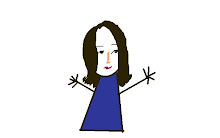
Since I'm creating a project poster and working on a book display, how to visually portray American Indian culture has been on my mind.
To the left there is a set of Thanksgiving puppets from an *unnamed* party supply catalog. I think we can do better. (For example, what in the heck is that brown blob in the upper left hand corner supposed to be? The facial similarity between the Mayflower and American Indian puppets is just a little bizarre, to say the least.) Here is some amateur advice on visual displays based on some of the issues that have been brought to my attention:
- Look beyond stock photos and clip art to find materials that actually reflect the Nations in your area. Don't just plop a tipi on the poster board and hope no one will notice.
- Try to seek out contemporary rather than historical photographs.
- DPI (WI) replicated some authentic beadwork patterns in one of their reference guides. Such patterns are better than the ambiguous "Indian blanket" borders.
- Avoid the phrase "celebrating" the culture. One bulletin board does not a celebration make. That's recognition. Which, I will admit, doesn't work into a title nearly as well.
- Respect the intense cultural significance of certain images, in particular ceremonial masks and eagle feathers.
- If you're trying to challenge your viewer with the inclusion of offensive images (which I wouldn't recommend to begin with), try to make this as visually clear as possible. A passerby may not take the time to read the text and may jump to conclusions about the nature of the display.

